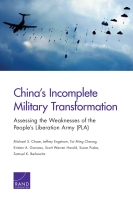
Research Questions
- What is the overall scope and scale of People's Liberation Army (PLA) modernization since the mid-1990s and what is its likely trajectory through 2025?
- What missions has Beijing assigned to the PLA?
- What are the weaknesses in the PLA's organization and human capital?
- What are the weaknesses in the PLA's combat capabilities in the land, air, maritime, space, and electromagnetic domains?
- What are the weaknesses in China's defense industry (research and development and production)?
Abstract
Through extensive primary source analysis and independent analysis, this report seeks to answer a number of important questions regarding the state of China's armed forces. What have been the overall scope and scale of People's Liberation Army (PLA) modernization since the mid-1990s, and what is its likely trajectory through 2025? What are the missions Beijing has assigned to the PLA? What are the weaknesses in the PLA's organization and human capital? What are the weaknesses in the PLA's combat capabilities in the land, air, maritime, space, and electromagnetic domains? What are the weaknesses in China's defense industry (research and development and production)? The authors found that the PLA is keenly aware of its many weaknesses and is vigorously striving to correct them. Chinese military publications recognize that this is a tall order. Indeed, the PLA leaders and official media frequently state that the force seeks to harness the capabilities of the information age to conduct complex joint operations, even though it is not yet fully mechanized or structured to command and control the campaigns it aspires to conduct. Although it is only natural to focus on the PLA's growing capabilities, the authors found that understanding the PLA's weaknesses — and its self-assessments of the shortcomings — is no less important. Doing so can help provide a sense of the PLA's priorities for future modernization efforts, support U.S. military engagement with the PLA, and inform the development of strategies to deter or defeat Chinese coercion or use of force.
Key Findings
The People's Liberation Army (PLA) Is Becoming More Professional and More Capable
- The PLA's capabilities aimed at deterring or, if necessary, countering U.S. military intervention in the Asia-Pacific region, including systems designed to hold U.S. military bases, aircraft carriers, space systems, and computer networks at risk have improved markedly.
This Transformation Is, However, Incomplete
- Chinese military media and PLA books and journal articles discuss the PLA's problems at length.
- The PLA's senior leadership speaks of the "two incompatibles," perceived gaps between current PLA capabilities and the demands of winning a local war under informatized conditions and successfully executing the PLA's other missions.
PLA's Organizational Structure and Human Capital Issues Are Sources of Concern
- The PLA's organizational structure appears to be an obstacle to its reaching the level of joint operations to which it aspires.
- The human capital shortcomings include such problems as insufficient education and technical proficiency and rampant corruption.
The PLA Also Has Shortfalls in Its Combat Capabilities
- PLA publications highlight shortcomings in joint operations capabilities, training, and combat support and combat service support functions.
- PLA is concerned about the integration of increasingly complex weapons and equipment, the associated training, the level of mastery of critical capabilities, insufficient numbers of key enablers and protecting China's growing interests in space and the electromagnetic spectrum.
- China's defense industry still suffers from a number of problems that have yet to be resolved, including widespread corruption, lack of competition, delays and cost overruns, and quality control issues.
Recommendations
- Analysts should devote greater attention to studying the PLA's weaknesses — and its self-assessments of its shortcomings — to inform assessments of the future direction of PLA modernization, support the development of a military-to-military relationship with China that advances U.S. interests, improve the ability of the United States and its allies and partners to deter China from using force or coercion to resolve disputes, and devise strategies for countering Chinese use of force if deterrence fails.
Table of Contents
- Chapter OneIntroduction: The Importance of Understanding the People's Liberation Army's Weaknesses
- Chapter TwoPeople's Liberation Army Modernization: Mid-1990s to 2025
- Chapter ThreeMissions of the People's Liberation Army
- Chapter FourWeaknesses in People's Liberation Army Organization and Human Capital
- Chapter FiveWeaknesses of People's Liberation Army Combat Capabilities
- Chapter SixWeaknesses in China's Defense Industry
- Chapter SevenConclusion: People's Liberation Army Weaknesses and Their Implications
- Appendix ACritical Assumptions
http://www.rand.org/content/dam/rand/pubs/research_reports/RR800/RR893/RAND_RR893.pdf
http://www.rand.org/pubs/research_reports/RR893.html

No comments:
Post a Comment
Note: Only a member of this blog may post a comment.